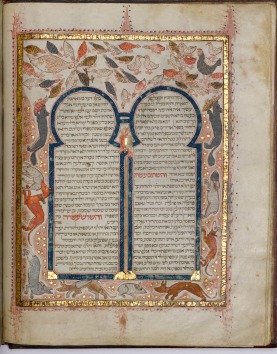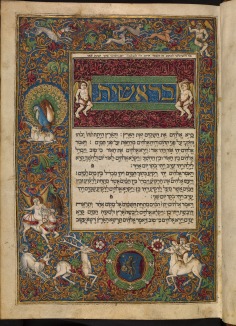
The medieval manuscripts currently on view at Manhattan’s Jewish Museum in Crossing Borders: Manuscripts from the Bodleian Libraries are stunning in their beauty. The exhibit, which draws from the superb holdings of Oxford’s famed library, includes paintings and printed books in addition to the manuscripts, situating them within the historical context of Christian Hebraism, the Christian study of the Hebrew Bible, and rabbinic sources. This scholarly movement flowered in the twelfth and thirteenth centuries and enjoyed a resurgence in the sixteenth, as Protestantism took hold throughout Europe. The fruits of the intellectual and artistic exchange among Christians, Jews, and Muslims are displayed in abundance throughout this small but splendid exhibit, which runs through early February.
 The collection pays eloquent tribute to the sustained vision of a great library. Thomas Bodley was a diplomat, humanist, and enthusiastic Christian Hebraist who considered a Hebraica collection an essential part of the new library he established in Oxford in 1602. Bodley’s vision has been carried on over the centuries with help from such luminaries as librarian Benjamin Kennicott, an eighteenth-century English Hebraist who acquired the lavishly illuminated medieval Hebrew Bible that bears his name; Matteo Luigi Canonici, a Jesuit whose collection, obtained in 1817, was the largest single purchase of manuscripts ever made by the library; and David Oppenheimer, an eighteenth-century rabbi who stored his huge private library at his father in-law’s house in Hanover, Germany, to avoid censorship imposed on Hebrew texts in Prague.
The collection pays eloquent tribute to the sustained vision of a great library. Thomas Bodley was a diplomat, humanist, and enthusiastic Christian Hebraist who considered a Hebraica collection an essential part of the new library he established in Oxford in 1602. Bodley’s vision has been carried on over the centuries with help from such luminaries as librarian Benjamin Kennicott, an eighteenth-century English Hebraist who acquired the lavishly illuminated medieval Hebrew Bible that bears his name; Matteo Luigi Canonici, a Jesuit whose collection, obtained in 1817, was the largest single purchase of manuscripts ever made by the library; and David Oppenheimer, an eighteenth-century rabbi who stored his huge private library at his father in-law’s house in Hanover, Germany, to avoid censorship imposed on Hebrew texts in Prague.
The works shown here, though not all religious, constitute a garden of heavenly delights. In the first room, the transition from scroll and rotulus (a vertical rather than horizontal scroll) to the highly portable codex in the late first century—a technological advance that early Christians were quick to use to disseminate their religious writings—is amply attested by fragments of a Torah scroll, a tenth-century rotulus written on both sides, and a range of variously-sized codices. The tidy columns of uncial letters in a late-sixth- or early-seventh-century Latin Vulgate are strikingly juxtaposed with the sprawling Syriac script of John’s Gospel from the Peshitta, the fifth-century Syriac Bible. There is a large Hebrew Bible open to a diagram of the Temple as delineated in Ezekiel 40–48, with the River of Paradise a vertical streak of blue running up the page. Nearby is the medieval rabbi Rashi’s commentary on the Prophets, with the decorative arrangement of the text itself an object of beauty. A Hebrew Psalter from the early thirteenth century is extensively annotated in Latin and French in the margins, a legacy of a lively personal engagement with the text that is increasingly lost to us in an electronic age.
Examples of cross-cultural conversation proliferate. They reflect the circumstances of the twelfth and thirteenth centuries, when Christian Hebraists turned to Jewish scholars for help with textual interpretation, Jewish scribes commissioned Christian artists to illustrate Hebrew manuscripts, and both groups interacted with Muslim culture. Thus one finds a New Testament in Arabic; beautiful samples of “carpet” pages in Jewish and Muslim texts; and – fairest of them all—the Kennicott Bible, a sumptuously illuminated manuscript created in fifteenth-century Spain by a Jewish scribe and a Jewish artist who drew on Christian, Islamic, and popular motifs. The Bible is open to the Sefer Mikhlol (“Book of Completeness”), the comprehensive grammatical treatise of David Kimchi, a thirteenth-century French Hebrew scholar; the Hebrew script is contained within four orderly Islamic horseshoe arches. Nearby the visitor can scroll through the entire Kennicott Bible by means of mounted iPads, a beneficent marriage of new technology and ancient text.
Two of the exhibit’s biggest gifts are wrapped in the smallest packages. The first is a tiny siddur, or Jewish book of prayers, measuring roughly 2x2½ inches, one of the smallest items in the Bodleian’s collection. The second is a marvelous micrographic Psalter, composed in minute and decoratively arranged script. With a magnifying glass (helpfully stowed in a bin near the door) one can just make out the final verse of the Psalter, kol haneshamah tehallel Yah—“Let everything that has breath praise the Lord”—engendering a lovely tension between the psalm’s tiny text and its all-encompassing sentiment.
 But the exhibit’s wonders come in all sizes and shapes. I was delighted to find a breviary from fifteenth-century Ferrara, graced by ornate floral decoration with a historiated initial “E” showing the Jewish King David seeking warmth from the young maiden Abishag, as recounted at the start of I Kings. The Holkham Hebrew Bible, produced in Naples in 1492, displays the opening verses of Genesis, the page illustrated with a woodcut borrowed from a Christian printer and reversed to accommodate the right-to-left Hebrew script. In another room I happened upon three medieval volumes of Euclid’s Elements of Geometry, all open to the same page—one in Latin, one in Hebrew, and one in Arabic.
But the exhibit’s wonders come in all sizes and shapes. I was delighted to find a breviary from fifteenth-century Ferrara, graced by ornate floral decoration with a historiated initial “E” showing the Jewish King David seeking warmth from the young maiden Abishag, as recounted at the start of I Kings. The Holkham Hebrew Bible, produced in Naples in 1492, displays the opening verses of Genesis, the page illustrated with a woodcut borrowed from a Christian printer and reversed to accommodate the right-to-left Hebrew script. In another room I happened upon three medieval volumes of Euclid’s Elements of Geometry, all open to the same page—one in Latin, one in Hebrew, and one in Arabic.
Cross-cultural exchange may also entail the refashioning of a text for a different cultural and linguistic audience. Kalila and Dimna, on display here, is the title of a collection of Sanskrit fables translated into Arabic in the eighth century. The collection made its way to the Iberian Peninsula, whence it was translated into Hebrew in the early thirteenth century, and eventually into Latin. In 1281, the Spanish Jew Isaac ben Solomon ibn Sahula wrote a collection of stories in rhymed prose to replace the original fables with a Hebrew original, which he titled The Fable of the Ancient—and in the coup de grâce, the illustrations in his volume drew on Christian models. So we have an Indian folk genre with Arabic influence adapted to Jewish literary purposes with a markedly Christian aesthetic influence.
As its title suggests, the exhibit wants to emphasize the enhanced understanding that grows from cross-cultural exchange and its activities, whether collaborating, borrowing, rewriting, or translating. Alas, irenic collaborations among artists are all too often given the lie by the cruel facts of history. Sixteen years after the completion of the Kennicott Bible, for instance, the Jews were expelled from the Iberian Peninsula; the Holkham Hebrew Bible, with the reverse woodcut, was created in Naples in 1492, and within twenty years the Jews were banished from that kingdom, too. Addressing this reality would have been outside the exhibition’s scope. But the question hangs in the air.
Perhaps it’s the case that calligraphy, like poetry, “makes nothing happen,” as Auden famously observed in his memorial for Yeats. In our day, after all, hopeful cross-cultural collaborations like the ones limned in this exhibit are just as routinely dashed by “real world” events. Witness the “Bridge Project,” the joint effort of an Israeli Jew, an Australian Christian, and a Turkish Muslim who composed a musical olio called Three Waves Under the Bridge (think Turkish rhythms, Western strings, and a bit of klezmer) by means of digital file-sharing and Skyped rehearsals. Within six months of the project’s completion, in May 2012, Hamas was sending rockets into Jerusalem and the Israelis were once again conducting an aerial campaign against Gaza.
Is it naïve to hope that artistic collaboration might spur political reconciliation? The exhibit at the Jewish Museum neither asks nor answers this question, and the historical track record is scarcely promising. But by showing how scribes, illuminators, and craftspeople of various cultural and religious stripes engaged in a dialogue across boundaries of all sorts, the curators of Crossing Borders have focused our attention on a little point of light that still shines across the centuries. In a world of darkness, this marvelous exhibit stands as an illuminating reminder of possibility.
Homepage image: Kalila and Dimna, in Arabic, Syria?, 1354. Bodleian Libraries, University of Oxford, MS. Pococke 400, fol. 75b
Upper image: Kennicott Bible, scribe: Moses ibn Zabara, artist: Joseph ibn Hayyim, commissioner: Isaac, son of Solomon di Braga, Corunna, Spain, 1476. Bodleian Libraries, University of Oxford, MS. Kennicott 1, fol. 7b
Lower image: Holkham Hebrew Bible, Naples, printed by Joshua Solomon Soncino, 1491 or 1492. Bodleian Libraries, University of Oxford, Holk. c.1, title page
Funding for this article was provided by a grant from the Henry Luce Foundation.
